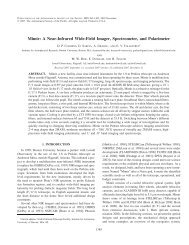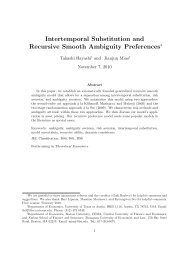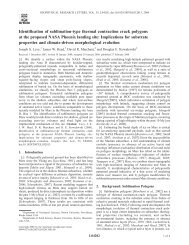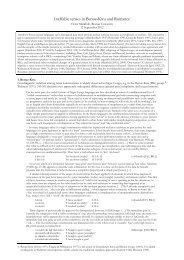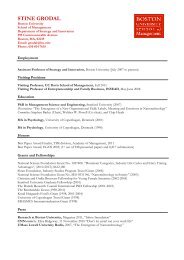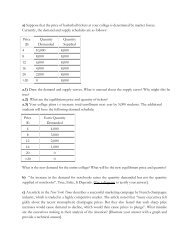Least Squares Temporal Difference Actor-Critic Methods with ...
Least Squares Temporal Difference Actor-Critic Methods with ...
Least Squares Temporal Difference Actor-Critic Methods with ...
You also want an ePaper? Increase the reach of your titles
YUMPU automatically turns print PDFs into web optimized ePapers that Google loves.
where ψ θ (x, u) = 0 when x, u are such that µ θ (u|x) ≡<br />
0 for all θ. It is assumed that ψ θ (x, u) is bounded<br />
and continuously differentiable. Note that ψ θ (x, u) =<br />
(ψθ 1(x, u), . . . , ψn θ<br />
(x, u)) where n is the dimensionality of θ.<br />
The convergence of the algorithm is stated in the following<br />
Theorem (see the technical report [18] for the proof).<br />
Theorem III.1 [<strong>Actor</strong> Convergence] For the LSTD actorcritic<br />
<strong>with</strong> some step-size sequence {β k } satisfying (7), for<br />
any ɛ > 0, there exists some λ sufficiently close to 1, such<br />
that lim inf k ||∇ᾱ(θ k )|| < ɛ w.p.1. That is, θ k visits an<br />
arbitrary neighborhood of a stationary point infinitely often.<br />
IV. THE MRP AND ITS CONVERSION INTO AN SSP<br />
PROBLEM<br />
In the MRP problem, we assume that there is a set of<br />
unsafe states which are set to be absorbing on the MDP<br />
(i.e., there is only one control at each state, corresponding to<br />
a self-transition <strong>with</strong> probability 1). Let X G and X U denote<br />
the set of goal states and unsafe states, respectively. A safe<br />
state is a state that is not unsafe. It is assumed that if the<br />
system is at a safe state, then there is at least one sequence of<br />
actions that can reach one of the states in X G <strong>with</strong> positive<br />
probability. Note that this implies that Assumption A holds.<br />
In the MRP, the goal is to find the optimal policy that<br />
maximizes the probability of reaching a state in X G from<br />
a given initial state. Note that since the unsafe states are<br />
absorbing, to satisfy this specification the system must not<br />
visit the unsafe states.<br />
We now convert the MRP problem into an SSP problem,<br />
which requires us to change the original MDP (now denoted<br />
as MDP M ) into a SSP MDP (denoted as MDP S ). Note that<br />
[3] established the equivalence between an MRP problem and<br />
an SSP problem where the expected reward is maximized.<br />
Here we present a different transformation where an MRP<br />
problem is converted to a more standard SSP problem where<br />
the expected cost is minimized.<br />
To begin, we denote the state space of MDP M by X M , and<br />
define X S , the state space of MDP S , to be<br />
X S = (X M \ X G ) ∪ {x ∗ },<br />
where x ∗ denotes a special termination state. Let x 0 denote<br />
the initial state, and U denote the action space of MDP M .<br />
We define the action space of MDP S to be U, i.e., the same<br />
as for MDP M .<br />
Let p M (j|x, u) denote the probability of transition to state<br />
j ∈ X M if action u is taken at state x ∈ X M . We now define<br />
the transition probability p S (j|x, u) for all states x, j ∈ X S<br />
as:<br />
⎧<br />
⎨<br />
p S (j|x, u) =<br />
⎩<br />
∑<br />
i∈X G<br />
p M (i|x, u), if j = x ∗ ,<br />
p M (j|x, u), if j ∈ X M \ X G ,<br />
for all x ∈ X M \ (X G ∪ X U ) and all u ∈ U. Furthermore, we<br />
set p S (x ∗ |x ∗ , u) = 1 and p S (x 0 |x, u) = 1 if x ∈ X U , for all<br />
u ∈ U. The transition probability of MDP S is defined to be<br />
the same as for MDP M , except that the probability of visiting<br />
(9)<br />
the goal states in MDP M is changed into the probability of<br />
visiting the termination state; and the unsafe states transit to<br />
the initial state <strong>with</strong> probability 1.<br />
For all x ∈ X S , we define the cost g(x, u) = 1 if x ∈ X U ,<br />
and g(x, u) = 0 otherwise. Define the expected total cost<br />
of a policy µ to be ᾱµ S = lim t→∞ E{ ∑ t−1<br />
k=0 g(x k, u k )|x 0 }<br />
where actions u k are obtained according to policy µ in<br />
MDP S . Moreover, for each policy µ on MDP S , we can<br />
define a policy on MDP M to be the same as µ for all states<br />
x ∈ X M \ (X G ∪ X U ). Since actions are irrelevant at the goal<br />
and unsafe states in both MDPs, <strong>with</strong> slight abuse of notation<br />
we denote both policies to be µ. Finally, we define the<br />
Reachability Probability Rµ<br />
M as the probability of reaching<br />
one of the goal states from x 0 under policy µ on MDP M .<br />
The Lemma below relates Rµ M and ᾱµ:<br />
S<br />
Lemma IV.1 For any RSP µ, we have R M µ = 1<br />
ᾱ S µ +1.<br />
Proof: See [18].<br />
The above lemma means that µ as a solution to the SSP<br />
problem on MDP S (minimizing ᾱ S µ) corresponds to a solution<br />
for the MRP problem on MDP M (maximizing R M µ ). Note that<br />
the algorithm uses a sequence of simulated trajectories, each<br />
of which starting at x 0 and ending as soon as x ∗ is visited for<br />
the first time in the sequence. Once a trajectory is completed,<br />
the state of the system is reset to the initial state x 0 and the<br />
process is repeated. Thus, the actor-critic algorithm is applied<br />
to a modified version of the MDP S where transition to a goal<br />
state is always followed by a transition to the initial state.<br />
V. CASE STUDY<br />
In this section we apply our algorithm to control a robot<br />
moving in a square-shaped mission environment, which is<br />
partitioned into 2500 smaller square regions (a 50 × 50 grid)<br />
as shown in Fig. 1. We model the motion of the robot in the<br />
environment as an MDP: each region corresponds to a state<br />
of the MDP, and in each region (state), the robot can take<br />
the following control primitives (actions): “North”, “East”,<br />
“South”, “West”, which represent the directions in which the<br />
robot intends to move (depending on the location of a region,<br />
some of these actions may not be enabled, for example, in<br />
the lower-left corner, only actions “North” and “East” are<br />
enabled). These control primitives are not reliable and are<br />
subject to noise in actuation and possible surface roughness<br />
in the environment. Thus, for each motion primitive at a<br />
region, there is a probability that the robot enters an adjacent<br />
region.<br />
We label the region in the south-west corner as the<br />
initial state. We marked the regions located at the other<br />
three corners as the set of goal states as shown in Fig. 1.<br />
We assume that there is a set of unsafe states X U in the<br />
environment (shown in black in Fig. 1). Our goal is to find<br />
the optimal policy that maximizes the probability of reaching<br />
a state in X G (set of goal states) from the initial state (an<br />
instance of an MRP problem).



